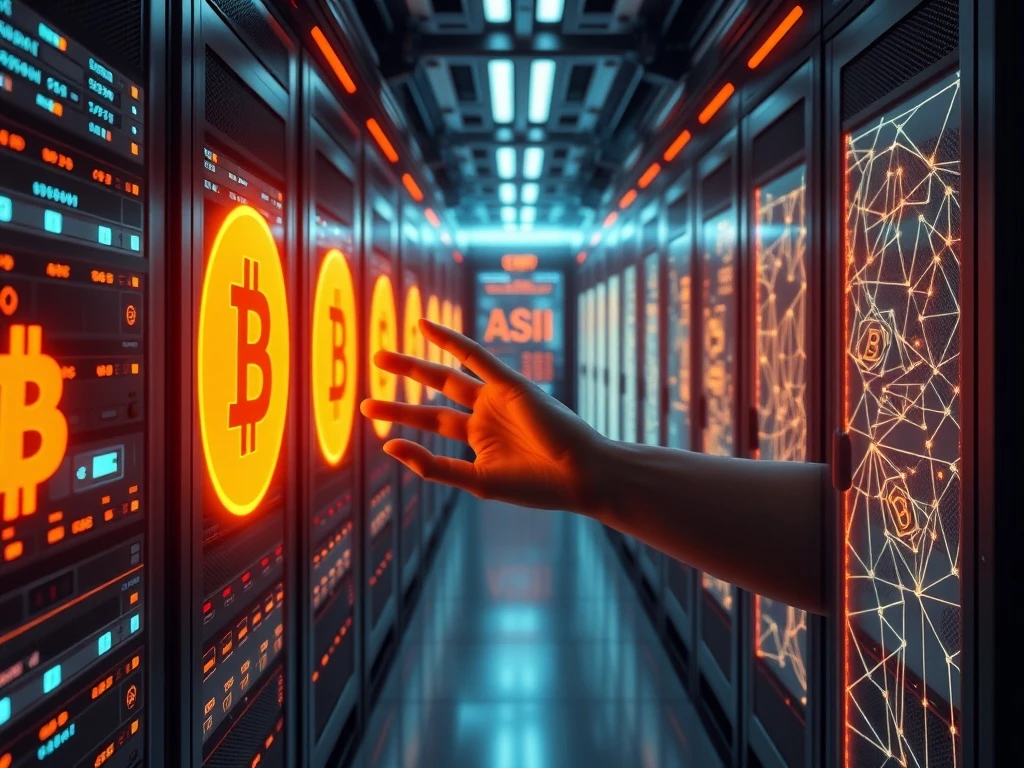Bitcoin Miners Unleash Profitable AI Shift: The $3.5B Opportunity

The cryptocurrency world is constantly evolving, and 2024 brought a seismic shift with the Bitcoin halving. This event, which cut block rewards in half, forced many Bitcoin miners to rethink their core strategies. Faced with reduced income, higher operational costs, and intense competition, traditional mining became less profitable. But instead of faltering, many savvy mining companies are now leveraging their existing assets to tap into a booming new market: artificial intelligence. This strategic pivot is not just about survival; it’s about unlocking a massive new revenue stream, transforming their operations into dual-purpose powerhouses.
Bitcoin Miners Embrace the AI Revolution
For years, Bitcoin miners have operated energy-intensive facilities, often in remote locations with access to cheap power. Their primary tools were Application-Specific Integrated Circuits (ASICs), specialized hardware designed solely for mining Bitcoin. However, the 2024 Bitcoin halving dramatically reduced the rewards, forcing miners to innovate. This wasn’t just about finding new income; it was about optimizing existing, valuable infrastructure. The answer for many has been a surprising yet logical shift: repurposing their energy-dense data centers to support the insatiable demand for artificial intelligence compute.
The synergy is clear: both Bitcoin mining and AI workloads demand immense power and robust cooling systems. Miners already possess the foundational elements – vast energy capacity, specialized data centers, and the expertise to manage complex hardware at scale. By upgrading their facilities with powerful Graphics Processing Units (GPUs), which are the backbone of AI training and inference, they can offer high-performance computing (HPC) services to a wide array of tech companies. This move provides a much-needed stable, non-crypto income stream, significantly reducing their reliance on Bitcoin’s volatile price movements and cushioning the impact of the halving.
Why AI Computing is the New Frontier for Miners
The demand for AI computing power is skyrocketing. From training large language models that power conversational AI to enabling autonomous systems and running sophisticated enterprise AI tools, the need for high-performance infrastructure is unprecedented. Tech giants and startups alike are in a frantic race to secure compute capacity, creating a lucrative market that Bitcoin mining firms are uniquely positioned to serve.
Miners’ existing energy infrastructure, often located in areas with abundant and affordable power, gives them a distinct advantage. While ASICs are specific to mining, the underlying data center architecture, power distribution, and cooling systems can be adapted for GPUs. This allows miners to offer AI cloud services or rent out spare capacity, diversifying their revenue streams beyond the unpredictable nature of cryptocurrency markets. This strategic move helps them offset the reduced profitability from Bitcoin halving and has led to more stable and robust financial models.
Strategic Crypto Mining Diversification in Action
The shift towards crypto mining diversification is not just theoretical; it’s already yielding significant results for several prominent players. Companies are demonstrating how a hybrid model can provide both stability and growth.
Core Scientific’s $3.5 Billion Lifeline
Core Scientific stands as a compelling example of how pivoting to AI can rescue a struggling Bitcoin mining company. After facing severe financial difficulties and filing for Chapter 11 bankruptcy in late 2022 due due to low Bitcoin prices and heavy debt, the company successfully restructured and re-emerged on Nasdaq in early 2024. Their turnaround strategy was largely fueled by a bold move into AI.
In June 2024, Core Scientific secured a monumental 12-year, $3.5 billion contract with CoreWeave, a leading AI cloud computing company. This agreement allows Core Scientific to dedicate a significant portion of its infrastructure to support CoreWeave’s high-performance computing needs. While the company’s Q1 2025 revenue was lower than the previous year, the AI strategy significantly boosted investor confidence. The market responded positively, with the company’s stock price surging after the CoreWeave deal was announced. By mid-2025, CoreWeave even reignited talks to acquire Core Scientific, underscoring the value created by this AI focus and its role in cushioning the impact of Bitcoin’s halving.
Hut 8’s AI Side Hustle
Hut 8 has adopted a complementary approach, integrating AI as a secondary income source while maintaining its core commitment to Bitcoin mining. This hybrid business model combines stability with growth potential, notably through a five-year contract that includes fixed payments and a revenue-sharing component. In September 2024, the company launched Highrise AI, a dedicated subsidiary offering GPU-as-a-Service, utilizing over 1,000 Nvidia H100 chips – specialized hardware crucial for advanced AI models. This marked Hut 8’s official entry into the high-performance computing (HPC) market.
Despite its AI venture, Hut 8 remains dedicated to Bitcoin mining, as evidenced by its continued investment in mining infrastructure and a substantial Bitcoin reserve of 10,273 BTC, making it one of the largest corporate Bitcoin holders globally. For Hut 8, AI is a strategic complement, diversifying revenue while Bitcoin mining remains central to its long-term vision.
| Company | Primary AI Strategy | Key Highlights | Impact |
|---|---|---|---|
| Core Scientific | Major AI cloud service provider | $3.5B contract with CoreWeave; bankruptcy recovery | Significant revenue diversification, increased investor confidence |
| Hut 8 | GPU-as-a-Service (Highrise AI) | 5-year contract, 1,000+ Nvidia H100s, strong BTC reserve | Complementary revenue, maintains Bitcoin mining focus |
| Hive Digital Technologies | Nvidia-powered GPU clusters for HPC | $30M investment, AI revenue tripled, $100M target by 2026 | Strong growth in AI revenue, rebranding reflects shift |
| Iren (Iris Energy) | AI cloud services with scaling GPU units | Scaled to 4,300+ GPUs, building AI-focused data centers | Dual revenue stream (BTC + AI), rapid expansion |
Powering the Future with GPU Cloud Services
As Bitcoin mining profits continue to tighten, the appeal of offering GPU cloud services has become undeniable. This model allows miners to leverage their existing power and cooling infrastructure by replacing or supplementing their ASICs with powerful GPUs, primarily Nvidia H100s, which are essential for complex AI computations. Companies like Hive Digital Technologies and Iren are leading the charge in proving that significant AI revenue can be generated without completely abandoning their Bitcoin roots.
Formerly known as Hive Blockchain, Hive Digital Technologies rebranded in mid-2023 to clearly signal its broader high-performance computing ambitions. Hive invested $30 million to deploy Nvidia-powered GPU clusters, making a decisive pivot towards AI workloads. This investment quickly paid off; in fiscal 2025, Hive’s AI and HPC hosting revenue tripled to $10.1 million, representing almost 9% of its total revenue. Looking ahead, Hive has set an ambitious target of $100 million in AI revenue by 2026, demonstrating strong commitment to its hybrid model.
Australian mining firm Iren (Iris Energy) embarked on its AI journey in early 2024 with just 248 GPUs, rapidly scaling to more than 4,300 units by mid-2025. Their hybrid model is already delivering results, mining 1,514 BTC in Q3 FY2025 while simultaneously generating $3.6 million from AI cloud services. To support this rapid growth, Iren is actively building AI-focused data centers in Texas and British Columbia. While facing a class-action lawsuit related to facility readiness, their rapid expansion into AI highlights the significant potential of this hybrid approach.
Optimizing Data Center Infrastructure for Dual Purpose
While some miners are already generating revenue from AI, others are strategically laying the groundwork, optimizing their data center infrastructure for future AI opportunities. Leading companies like Riot Platforms and MARA Holdings are planning for AI integration while maintaining their core focus on Bitcoin mining.
Riot Platforms is actively exploring AI possibilities, assessing the potential to convert 600 megawatts at its massive Corsicana, Texas, facility into high-performance computing (HPC) infrastructure. While Riot has not yet secured major AI contracts, its Corsicana site, spanning 355 acres, boasts the capacity to support up to 1 gigawatt of computing power. This immense scale provides a decisive advantage for future AI expansion. Financially, Riot remains robust in its primary business, having mined 1,530 BTC and earning $142.9 million in mining revenue in Q1 2025, supported by one of the largest corporate Bitcoin reserves globally (19,225 BTC as of July 2025).
MARA Holdings possesses the most extensive Bitcoin treasury among mining companies, holding 50,000 BTC. Their AI strategy centers on edge computing, including the development of their proprietary MARA 2PIC700 immersion cooling system, specifically designed to handle intensive computing tasks required by AI. While MARA has the infrastructure ready, its AI efforts have not yet translated into significant contracts or consistent revenue. For now, a move into AI remains a forward-looking strategy with considerable potential for future growth.
It’s worth noting that Bitcoin mining relies on ASICs, but AI requires GPUs like Nvidia’s H100s. Many miners are now retrofitting existing data centers with GPUs to support AI clients, creating truly dual-purpose infrastructure that balances both blockchain and AI demands. This also presents an environmental advantage: AI firms are under pressure to go green, and Bitcoin miners already utilizing renewable energy sources like hydro or solar can attract AI clients seeking to meet sustainability targets through clean colocation deals.
Navigating the Risks: A Balanced Approach to AI Integration
While the transition of Bitcoin miners into AI offers tremendous opportunities, it also comes with significant risks that companies must carefully navigate:
- Infrastructure Costs vs. Returns: Shifting from ASIC-based mining to GPU-based AI systems demands substantial initial investment. Miners must ensure that the potential long-term revenue outweighs these significant costs.
- Client Stability: AI clients, especially startups, may lack consistent funding or long-term reliability. Miners should carefully evaluate potential clients to mitigate risks of payment defaults or service interruptions.
- Power Supply Reliability: AI operations require continuous, high-energy usage. Miners must secure stable, long-term power agreements and monitor local grid capacity to prevent outages or sudden price increases that could impact profitability.
- Cooling and Thermal Management: High-performance AI chips, such as Nvidia H100s, generate immense heat. Inadequate or inefficient cooling systems can lead to equipment failures, reduced operational efficiency, and higher maintenance costs.
- Regulatory Compliance: Hosting AI workloads involves complex regulations related to data privacy, intellectual property, international data hosting, energy use, water consumption, and carbon emissions. Miners must be prepared to navigate this intricate regulatory landscape.
- Market Competition: As more miners enter the AI colocation market, pricing could decline due to increased supply. Early entrants need to establish distinct advantages, such as strategic locations, exceptionally low energy costs, or specialized large-scale operations.
- Resource Strain: Expanding into AI while simultaneously maintaining robust mining operations can potentially overstretch financial and management resources, impacting efficiency in both areas.
An Outlier Case: Canaan’s Retreat from AI
While the trend is clearly towards AI diversification, Canaan has taken a different path. In July 2025, the company made the strategic decision to close its AI chip division, stepping away from the high-performance computing sector. This move signals a renewed focus on its primary expertise: designing application-specific integrated circuits (ASICs) for Bitcoin mining. Instead of chasing the growing AI market, Canaan aims to advance its mining hardware to maintain a competitive edge, despite holding only 2.1% of the global ASIC market, trailing leaders like Bitmain and MicroBT. By prioritizing mining-focused hardware and strengthening its presence in markets like North America, Canaan is adopting a unique, counter-trend strategy. The long-term success of this specialized approach remains to be seen.
The Future is Hybrid: A Compelling Summary
The landscape for Bitcoin miners is rapidly transforming. The 2024 halving acted as a powerful catalyst, pushing companies to explore innovative revenue streams beyond traditional block rewards. The burgeoning demand for AI computing power has presented a perfect opportunity for miners to leverage their existing data center infrastructure, transforming them into dual-purpose facilities capable of both mining Bitcoin and providing crucial GPU cloud services.
Companies like Core Scientific, Hut 8, Hive, and Iren are proving the viability and profitability of this crypto mining diversification. While challenges such as infrastructure costs, regulatory complexities, and market competition exist, the potential for stable, long-term revenue streams is immense. The strategic shift by Bitcoin miners into the AI sector is not merely a survival tactic; it’s a testament to their adaptability and foresight. This convergence of crypto and AI is setting the stage for a new era of digital infrastructure, where the energy-intensive world of blockchain meets the computational demands of artificial intelligence, creating a truly exciting and profitable future for those bold enough to embrace it.









